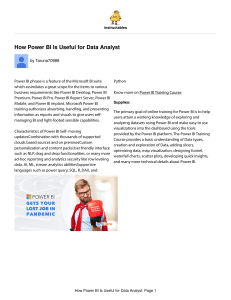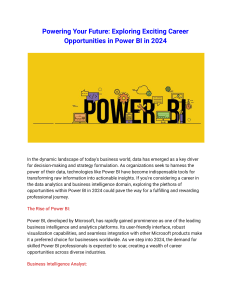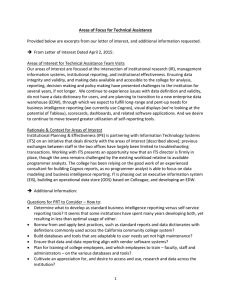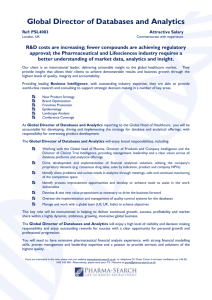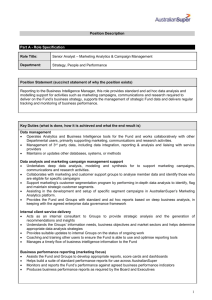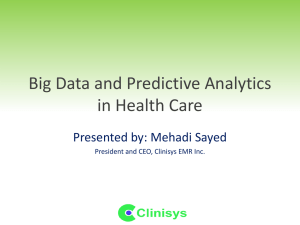Understanding Your Risks with Analytics
advertisement
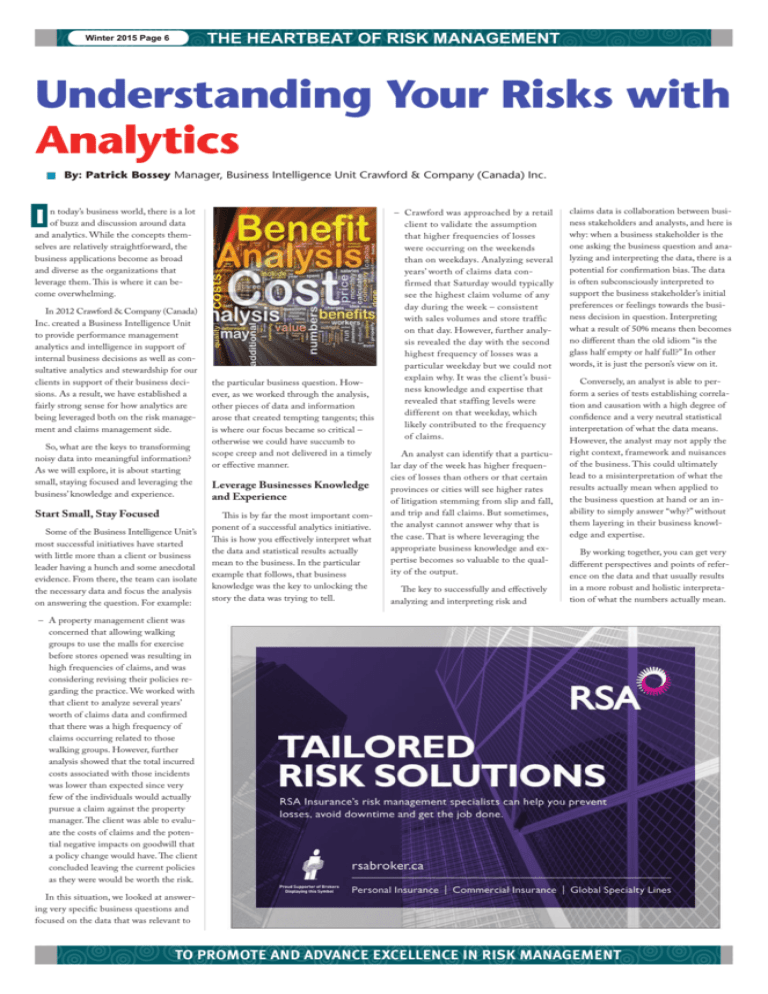
THE HEARTBEAT OF RISK MANAGEMENT Winter 2015 Page 6 Understanding Your Risks with Analytics By: Patrick Bossey Manager, Business Intelligence Unit Crawford & Company (Canada) Inc. business world, there is a lot I noftoday’s buzz and discussion around data and analytics. While the concepts themselves are relatively straightforward, the business applications become as broad and diverse as the organizations that leverage them. is is where it can become overwhelming. In 2012 Crawford & Company (Canada) Inc. created a Business Intelligence Unit to provide performance management analytics and intelligence in support of internal business decisions as well as consultative analytics and stewardship for our clients in support of their business decisions. As a result, we have established a fairly strong sense for how analytics are being leveraged both on the risk management and claims management side. So, what are the keys to transforming noisy data into meaningful information? As we will explore, it is about starting small, staying focused and leveraging the business’ knowledge and experience. Start Small, Stay Focused Some of the Business Intelligence Unit’s most successful initiatives have started with little more than a client or business leader having a hunch and some anecdotal evidence. From there, the team can isolate the necessary data and focus the analysis on answering the question. For example: the particular business question. However, as we worked through the analysis, other pieces of data and information arose that created tempting tangents; this is where our focus became so critical – otherwise we could have succumb to scope creep and not delivered in a timely or effective manner. Leverage Businesses Knowledge and Experience is is by far the most important component of a successful analytics initiative. is is how you effectively interpret what the data and statistical results actually mean to the business. In the particular example that follows, that business knowledge was the key to unlocking the story the data was trying to tell. – Crawford was approached by a retail client to validate the assumption that higher frequencies of losses were occurring on the weekends than on weekdays. Analyzing several years’ worth of claims data confirmed that Saturday would typically see the highest claim volume of any day during the week – consistent with sales volumes and store traffic on that day. However, further analysis revealed the day with the second highest frequency of losses was a particular weekday but we could not explain why. It was the client’s business knowledge and expertise that revealed that staffing levels were different on that weekday, which likely contributed to the frequency of claims. An analyst can identify that a particular day of the week has higher frequencies of losses than others or that certain provinces or cities will see higher rates of litigation stemming from slip and fall, and trip and fall claims. But sometimes, the analyst cannot answer why that is the case. That is where leveraging the appropriate business knowledge and expertise becomes so valuable to the quality of the output. e key to successfully and effectively analyzing and interpreting risk and claims data is collaboration between business stakeholders and analysts, and here is why: when a business stakeholder is the one asking the business question and analyzing and interpreting the data, there is a potential for confirmation bias. e data is often subconsciously interpreted to support the business stakeholder’s initial preferences or feelings towards the business decision in question. Interpreting what a result of 50% means then becomes no different than the old idiom “is the glass half empty or half full?” In other words, it is just the person’s view on it. Conversely, an analyst is able to perform a series of tests establishing correlation and causation with a high degree of confidence and a very neutral statistical interpretation of what the data means. However, the analyst may not apply the right context, framework and nuisances of the business. This could ultimately lead to a misinterpretation of what the results actually mean when applied to the business question at hand or an inability to simply answer “why?” without them layering in their business knowledge and expertise. By working together, you can get very different perspectives and points of reference on the data and that usually results in a more robust and holistic interpretation of what the numbers actually mean. – A property management client was concerned that allowing walking groups to use the malls for exercise before stores opened was resulting in high frequencies of claims, and was considering revising their policies regarding the practice. We worked with that client to analyze several years’ worth of claims data and confirmed that there was a high frequency of claims occurring related to those walking groups. However, further analysis showed that the total incurred costs associated with those incidents was lower than expected since very few of the individuals would actually pursue a claim against the property manager. e client was able to evaluate the costs of claims and the potential negative impacts on goodwill that a policy change would have. e client concluded leaving the current policies as they were would be worth the risk. In this situation, we looked at answering very specific business questions and focused on the data that was relevant to TO PROMOTE AND ADVANCE EXCELLENCE IN RISK MANAGEMENT
